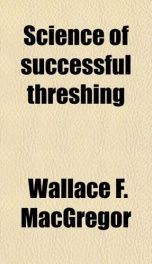science of successful threshing

Purchase of this book includes free trial access to www.million-books.com where you can read more than a million books for free. This is an OCR edition with typos. Excerpt from book: CHAPTER III FIRING WITH VARIOUS FUELS TO maintain a uniform steam pressure with any kind of fuel, the draft should be sufficient and the fire should be supplied with air from below. No cold air should be allowed to get to the tubes except by passing through live coals that may ignite fresh fuel. The cone screen in the stack should be straight and the exhaust nozzle should be of the proper size and pointed straight with the stack. This latter is of great importance. The ash pan must not be allowed to fill up, or warped and melted grates are sure to result. There is no excuse for allowing the ash pan to fill up, and a good engineer never permits it to do so. With coal, wood or oil, the firing is done by the engineer, but with straw for fuel, it is usual to have an extra man or boy for this purpose. How to Fire with Coal. Keep the grates well covered, but with as thin a fire as possible. Do not throw in large lumps of coal or put in very much at a time. A thin fire lightly and frequently renewed is the most economical. The engine should be allowed to blow off once a day to see if the steam gage and pop valve agree, but if the pop valvefrequently opens, it is an indication that the fireman is either careless or unable to control his fire. The best way to check the rise of steam is to start the injector, but if the boiler be too full, the damper may be closed. Another way is to open the fire door about an inch, leaving the damper open, but the door should never be held open more than this amount. This will do no harm to tubes or boiler, but while the engine is running the door should never be opened when the damper is closed. When the engine is to be shut down for any length of time the smoke-box door may be opened to check the fire. Some grades of coal will form clin...
Info about the book
Author:
Series:
Unknown
ISBN:
1112406468
Rating:
4/5 (4)Your rating:
0/5
Languge:
English
Users who have this book
Users who want this book
What readers are saying
What do you think? Write your own comment on this book!
write a commentif you like science of successful threshing try:
Other books by this author
Do you want to read a book that interests you? It’s EASY!
Create an account and send a request for reading to other users on the Webpage of the book!

